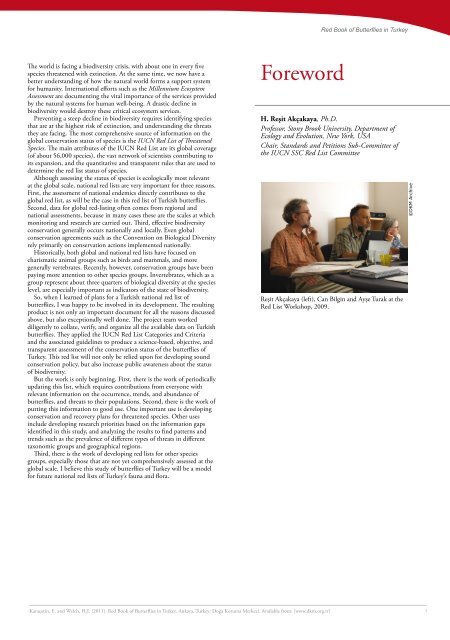Red Book of Butterflies in Turkey Red Book of Butterflies in Turkey
Red Book of Butterflies in Turkey Red Book of Butterflies in Turkey
Red Book of Butterflies in Turkey Red Book of Butterflies in Turkey
You also want an ePaper? Increase the reach of your titles
YUMPU automatically turns print PDFs into web optimized ePapers that Google loves.
The world is fac<strong>in</strong>g a biodiversity crisis, with about one <strong>in</strong> every five<br />
species threatened with ext<strong>in</strong>ction. At the same time, we now have a<br />
better understand<strong>in</strong>g <strong>of</strong> how the natural world forms a support system<br />
for humanity. International efforts such as the Millennium Ecosystem<br />
Assessment are document<strong>in</strong>g the vital importance <strong>of</strong> the services provided<br />
by the natural systems for human well-be<strong>in</strong>g. A drastic decl<strong>in</strong>e <strong>in</strong><br />
biodiversity would destroy these critical ecosystem services.<br />
Prevent<strong>in</strong>g a steep decl<strong>in</strong>e <strong>in</strong> biodiversity requires identify<strong>in</strong>g species<br />
that are at the highest risk <strong>of</strong> ext<strong>in</strong>ction, and understand<strong>in</strong>g the threats<br />
they are fac<strong>in</strong>g. The most comprehensive source <strong>of</strong> <strong>in</strong>formation on the<br />
global conservation status <strong>of</strong> species is the IUCN <strong>Red</strong> List <strong>of</strong> Threatened<br />
Species. The ma<strong>in</strong> attributes <strong>of</strong> the IUCN <strong>Red</strong> List are its global coverage<br />
(<strong>of</strong> about 56,000 species), the vast network <strong>of</strong> scientists contribut<strong>in</strong>g to<br />
its expansion, and the quantitative and transparent rules that are used to<br />
determ<strong>in</strong>e the red list status <strong>of</strong> species.<br />
Although assess<strong>in</strong>g the status <strong>of</strong> species is ecologically most relevant<br />
at the global scale, national red lists are very important for three reasons.<br />
First, the assessment <strong>of</strong> national endemics directly contributes to the<br />
global red list, as will be the case <strong>in</strong> this red list <strong>of</strong> Turkish butterflies.<br />
Second, data for global red-list<strong>in</strong>g <strong>of</strong>ten comes from regional and<br />
national assessments, because <strong>in</strong> many cases these are the scales at which<br />
monitor<strong>in</strong>g and research are carried out. Third, effective biodiversity<br />
conservation generally occurs nationally and locally. Even global<br />
conservation agreements such as the Convention on Biological Diversity<br />
rely primarily on conservation actions implemented nationally.<br />
Historically, both global and national red lists have focused on<br />
charismatic animal groups such as birds and mammals, and more<br />
generally vertebrates. Recently, however, conservation groups have been<br />
pay<strong>in</strong>g more attention to other species groups. Invertebrates, which as a<br />
group represent about three quarters <strong>of</strong> biological diversity at the species<br />
level, are especially important as <strong>in</strong>dicators <strong>of</strong> the state <strong>of</strong> biodiversity.<br />
So, when I learned <strong>of</strong> plans for a Turkish national red list <strong>of</strong><br />
butterflies, I was happy to be <strong>in</strong>volved <strong>in</strong> its development. The result<strong>in</strong>g<br />
product is not only an important document for all the reasons discussed<br />
above, but also exceptionally well done. The project team worked<br />
diligently to collate, verify, and organize all the available data on Turkish<br />
butterflies. They applied the IUCN <strong>Red</strong> List Categories and Criteria<br />
and the associated guidel<strong>in</strong>es to produce a science-based, objective, and<br />
transparent assessment <strong>of</strong> the conservation status <strong>of</strong> the butterflies <strong>of</strong><br />
<strong>Turkey</strong>. This red list will not only be relied upon for develop<strong>in</strong>g sound<br />
conservation policy, but also <strong>in</strong>crease public awareness about the status<br />
<strong>of</strong> biodiversity.<br />
But the work is only beg<strong>in</strong>n<strong>in</strong>g. First, there is the work <strong>of</strong> periodically<br />
updat<strong>in</strong>g this list, which requires contributions from everyone with<br />
relevant <strong>in</strong>formation on the occurrence, trends, and abundance <strong>of</strong><br />
butterflies, and threats to their populations. Second, there is the work <strong>of</strong><br />
putt<strong>in</strong>g this <strong>in</strong>formation to good use. One important use is develop<strong>in</strong>g<br />
conservation and recovery plans for threatened species. Other uses<br />
<strong>in</strong>clude develop<strong>in</strong>g research priorities based on the <strong>in</strong>formation gaps<br />
identified <strong>in</strong> this study, and analyz<strong>in</strong>g the results to f<strong>in</strong>d patterns and<br />
trends such as the prevalence <strong>of</strong> different types <strong>of</strong> threats <strong>in</strong> different<br />
taxonomic groups and geographical regions.<br />
Third, there is the work <strong>of</strong> develop<strong>in</strong>g red lists for other species<br />
groups, especially those that are not yet comprehensively assessed at the<br />
global scale. I believe this study <strong>of</strong> butterflies <strong>of</strong> <strong>Turkey</strong> will be a model<br />
for future national red lists <strong>of</strong> <strong>Turkey</strong>’s fauna and flora.<br />
Foreword<br />
H. Reşit Akçakaya, Ph.D.<br />
Pr<strong>of</strong>essor, Stony Brook University, Department <strong>of</strong><br />
Ecology and Evolution, New York, USA<br />
Chair, Standards and Petitions Sub-Committee <strong>of</strong><br />
the IUCN SSC <strong>Red</strong> List Committee<br />
Karaçet<strong>in</strong>, E. and Welch, H.J. (2011). <strong>Red</strong> <strong>Book</strong> <strong>of</strong> <strong>Butterflies</strong> <strong>in</strong> <strong>Turkey</strong>. Ankara, <strong>Turkey</strong>: Doğa Koruma Merkezi. Available from: [www.dkm.org.tr]<br />
<strong>Red</strong> <strong>Book</strong> <strong>of</strong> <strong>Butterflies</strong> <strong>in</strong> <strong>Turkey</strong><br />
Reşit Akçakaya (left), Can Bilg<strong>in</strong> and Ayşe Turak at the<br />
<strong>Red</strong> List Workshop, 2009.<br />
©DKM Archive<br />
1


